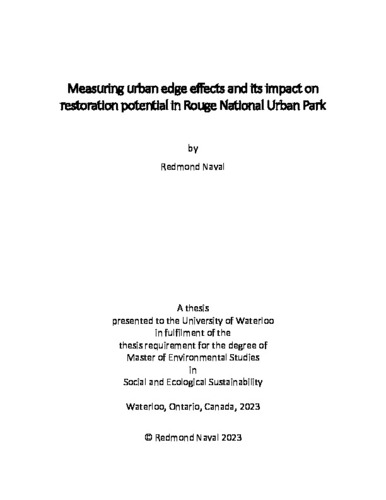| dc.contributor.author | Naval, Redmond | |
| dc.date.accessioned | 2024-02-21 13:48:08 (GMT) | |
| dc.date.available | 2024-02-21 13:48:08 (GMT) | |
| dc.date.issued | 2024-02-21 | |
| dc.date.submitted | 2024-02-12 | |
| dc.identifier.uri | http://hdl.handle.net/10012/20352 | |
| dc.description.abstract | Urban development is a driving force behind habitat fragmentation and biodiversity loss in major metropolitan areas. While greenspaces and naturalized areas can provide resources for wildlife, urban areas are organized in such a way that the transition from forest to suburban neighbourhood is abrupt and heavily maintained. This arrangement in conjunction with the intensity of urban activities leaves a limited area to buffer any anthropogenic impacts, negatively affecting species that are unable to adapt. To examine the extent to which urban activities are affecting naturalized areas, a one-sided edge effect study was conducted in Rouge National Urban Park (RNUP) in Toronto, Ontario, Canada. The purpose of this study was to frame what kinds of restoration plans might be possible given the amount of least impacted area, i.e., interior conditions. Data were collected in the largest accessible forest fragment, with one primary edge being sampled. 13 transects of 500 m length were used, with samples taken at the following distances d from the edge: 0 m, 50 m, 125 m, 250 m, and 500 m. Reference conditions were categorized as those found at d = 500 m. The Shannon Diversity Index and Pielou Evenness Index were used to compare plant species composition and analyzed using a randomized test of edge influence without blocking. The distance of edge influence was not observable, with no distance found to be significantly different from reference conditions. The results may be due to data noise from other nearby edges, primarily a large informal trail network whose presence was not known prior to data collection. Had these additional sources of fragmentation been observed, it would have resulted in smaller sampling fragments with inherently less potential interior habitat. It may also be the result of non-typical urban edge conditions at d = 0 m as it ran parallel to metal fencing and lay beneath a mature canopy. The edge had a sheltered side-canopy in contrast to an expected open forest edge that is exposed to disturbances such as increased light exposure and heavy anthropogenic activity. Additional observations may indicate limited interior conditions in the studied area of RNUP. Though not examined specifically, evidence of anthropogenic impacts was not contained to the defined fragment edges and permeated every area of the park. Given how impacted RNUP appears to be, improvements to ecological integrity seem unlikely unless accompanied by a broader landscape approach. Restoration activities may help reduce further biodiversity loss and bolster other ecosystem services provided by the park. Due to the complexity of potential influencing factors, this research is the beginnings of a foundational framework that sought to better understand priorities and best practices for ecological restoration in major urban areas. Subsequent research is expected to develop a deeper understanding of the drivers behind observed edge conditions. | en |
| dc.language.iso | en | en |
| dc.publisher | University of Waterloo | en |
| dc.subject | edge effect | en |
| dc.subject | urban | en |
| dc.subject | ecological integrity | en |
| dc.subject | ecological restoration | en |
| dc.subject | Rouge National Urban Park | en |
| dc.subject | randomized test of edge influence | en |
| dc.subject | distance of edge influence | en |
| dc.subject | magnitude of edge influence | en |
| dc.subject | species diversity | en |
| dc.subject | species evenness | en |
| dc.subject | protected area | en |
| dc.subject | novel ecosystem | en |
| dc.title | Measuring urban edge effects and its impact on restoration potential in Rouge National Urban Park | en |
| dc.type | Master Thesis | en |
| dc.pending | false | |
| uws-etd.degree.department | School of Environment, Resources and Sustainability | en |
| uws-etd.degree.discipline | Social and Ecological Sustainability | en |
| uws-etd.degree.grantor | University of Waterloo | en |
| uws-etd.degree | Master of Environmental Studies | en |
| uws-etd.embargo.terms | 0 | en |
| uws.contributor.advisor | Murphy, Stephen D. | |
| uws.contributor.affiliation1 | Faculty of Environment | en |
| uws.published.city | Waterloo | en |
| uws.published.country | Canada | en |
| uws.published.province | Ontario | en |
| uws.typeOfResource | Text | en |
| uws.peerReviewStatus | Unreviewed | en |
| uws.scholarLevel | Graduate | en |

